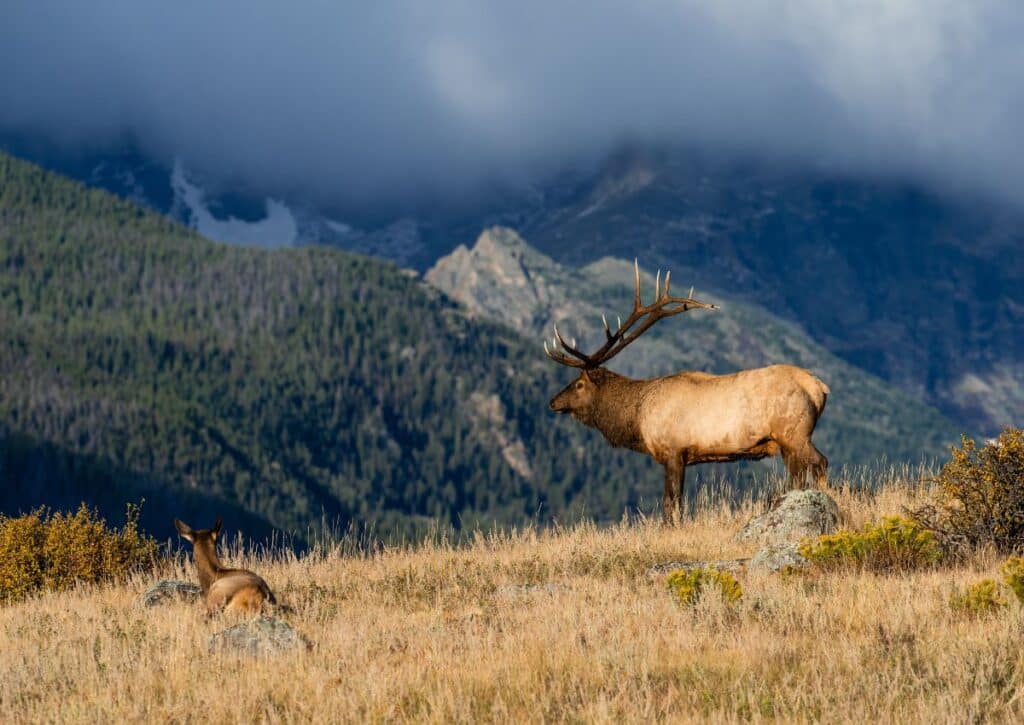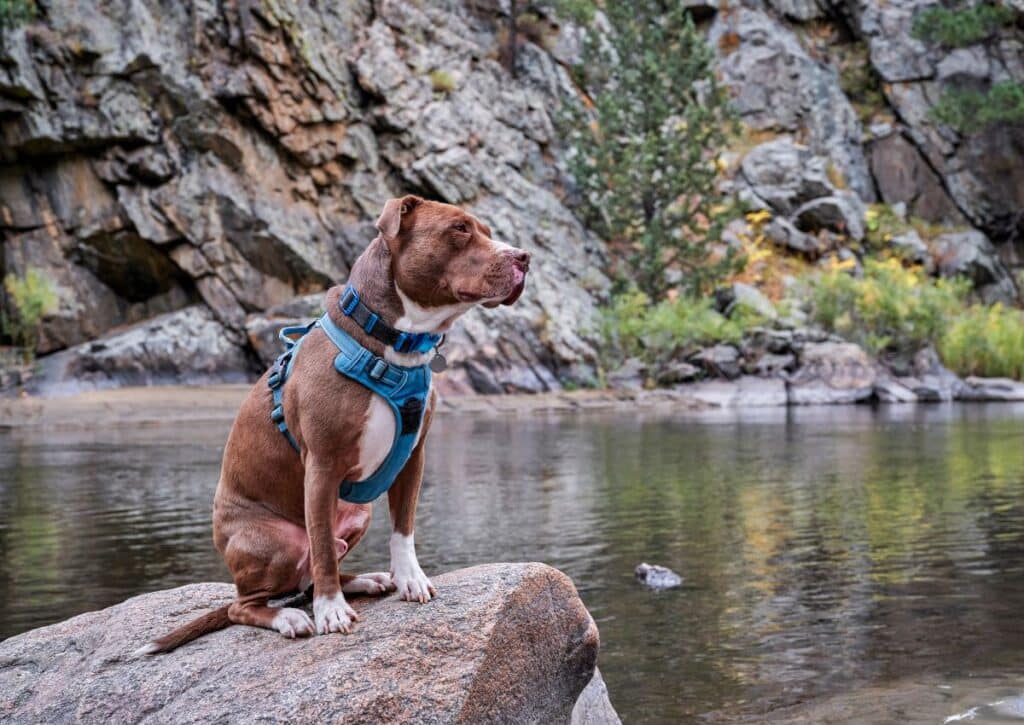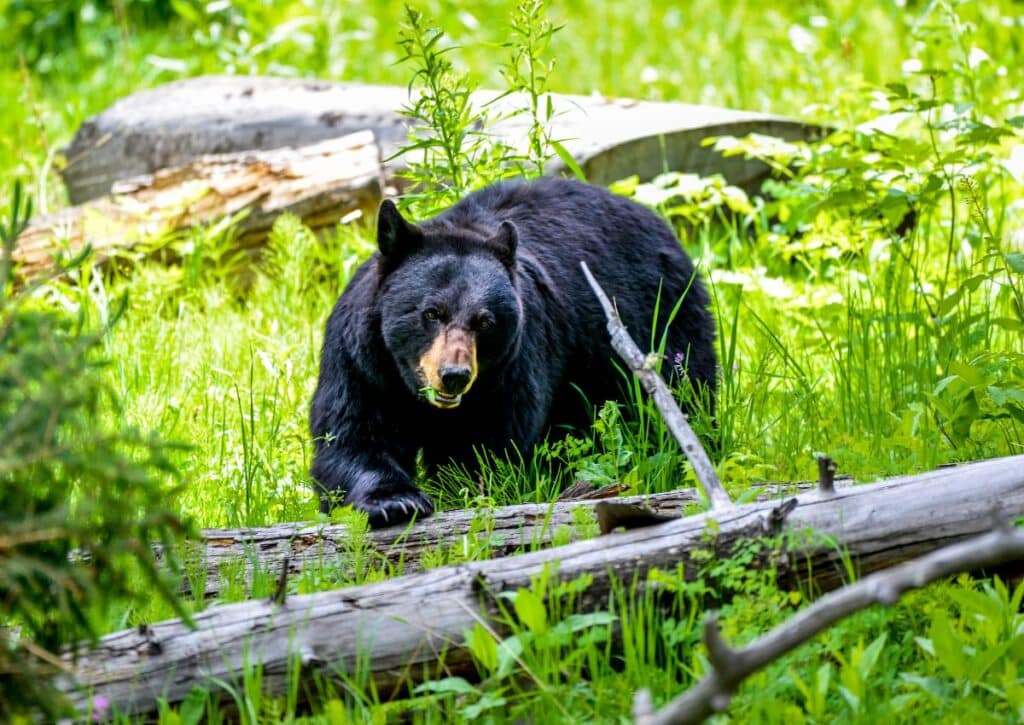Discover 19 animals in Arapaho National Forest, tips for sightings, and trail guides in our article.
Heading into Arapaho National Forest feels like stepping into an animal kingdom adventure. Imagine rounding a bend to find elk locking antlers or catching a glimpse of a bobcat’s retreat.
This isn’t just a walk in the woods; it’s a front-row seat to the secret lives of Arapaho’s residents — from the high-pitched chirp of the pika to the stately stride of a moose.
Our tell-all guide is packed with the who’s who of the forest’s critters, the when and where to spot them, and photo tips to capture your ‘wow’ moments.
We’ve tracked the trails where wildlife pop by to say ‘hello,’ and we’re sharing it all. Lace up your boots, charge your camera, and let’s get wild!
Overview of the Wilderness in Arapaho National Forest
Arapaho National Forest, located primarily in the Rocky Mountains of north-central Colorado, is a sprawling wilderness that covers over 700,000 acres.
During our visits, we were captivated by its diverse landscapes, which include the towering peaks of the Continental Divide, serene alpine lakes like Lake Granby, and dense forests dominated by spruce, fir, and pine trees.
One of the forest’s standout features is the Indian Peaks Wilderness, a section we highly recommend for its breathtaking vistas and challenging trails.
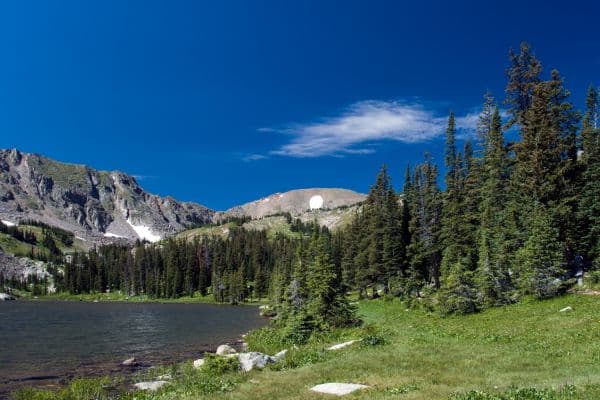
Here, we encountered diverse habitats that support a myriad of wildlife, from the elusive bobcat to the graceful elk. The forest’s elevation ranges from around 8,000 feet to well over 14,000 feet, giving rise to distinct ecological zones.
For those keen on birdwatching, the forested areas near Monarch Lake proved fruitful for us, revealing sightings of mountain bluebirds and lark buntings. If you’re planning a visit, we suggest starting at the Sulphur Ranger District, where you can gather valuable information on trail conditions and wildlife activity.
Remember, Arapaho isn’t just a forest; it’s a vibrant ecosystem, and with every step, there’s an opportunity to learn and marvel at nature’s wonders.
Mountain Lions
Mountain lions, often referred to as cougars or pumas, are among the most majestic and elusive predators of Arapaho National Forest. With their tawny coats and stealthy movements, they command respect from all who tread within their territory.
These solitary hunters primarily roam vast areas, making them a rare sight, but the thrill of spotting one is unparalleled.
For those eager to catch a glimpse, the Indian Peaks Wilderness offers some promise. The Cascade Creek trail, a 15.5-mile round trip that winds through dense forests and open meadows, has had occasional sightings.
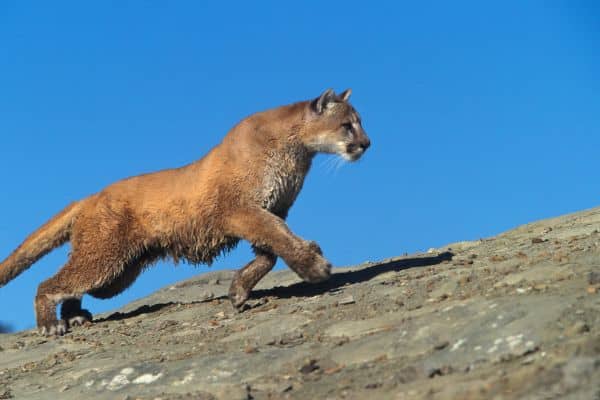
Similarly, the Arapaho Pass trail, a moderately challenging 6.2-mile hike offering panoramic views, is another hotspot. Both trails, with their mix of terrains, provide the ideal backdrop for these predators to hunt and thrive.
Interestingly, mountain lions are incredibly adaptable, capable of living in diverse habitats from mountains to deserts. Their diet mainly consists of deer, but they’ve been known to prey on smaller animals too.
A lesser-known fact is their ability to swim and climb trees, showcasing their versatility in the wild. If you’re venturing into their domain, always remember to hike in groups and stay alert, especially during dawn or dusk when they’re most active.
Big Horn Sheep
Big Horn Sheep are iconic residents of the Arapaho National Forest, easily recognizable by their massive, curled horns and robust build. These majestic animals are not just a symbol of the American West but also a testament to nature’s ability to adapt and thrive in rugged terrains.
One of the best places to observe these magnificent creatures is the Mount Flora Trail, an 8.4-mile round trip that offers expansive alpine landscapes. The trail’s higher elevations and rocky outcrops are favored by the sheep, providing them with both grazing opportunities and vantage points to spot predators.
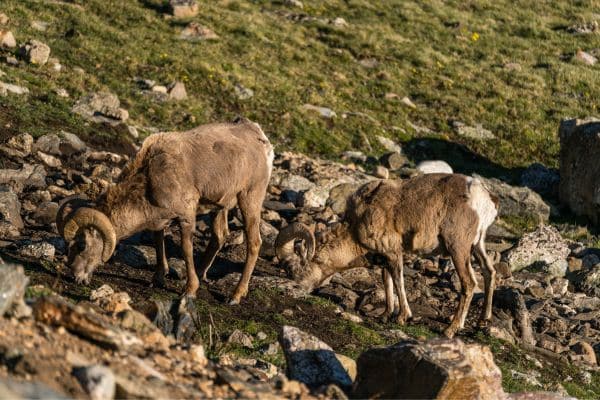
Another promising location is the James Peak Lake Trail, a 9-mile journey that traverses through varied terrains, from lush meadows to stark ridges. The trail’s open spaces often serve as grazing grounds for the sheep, especially during early mornings.
Big Horn Sheep are social animals, typically seen in groups. While males boast larger horns used in combat for mating rights, females have shorter, less curved horns.
Their incredible agility allows them to navigate steep cliffs and rocky terrains with ease. If you’re lucky enough to spot a herd, it’s a sight to behold, especially during the rutting season when males engage in head-butting contests.
When observing, always maintain a safe distance and use binoculars or a camera zoom to get a closer look without disturbing their natural behavior.
Elk
Elk, with their majestic antlers and regal stance, are a defining presence in the Arapaho National Forest. These large herbivores, often heard before they’re seen due to their distinctive bugling calls, play a vital role in the ecosystem and are a delight for wildlife enthusiasts.
For the best chances of spotting these magnificent creatures, the Monarch Lake Loop Trail is a prime location. This relatively flat 4-mile loop encircles a serene lake and offers ample meadows where elk are frequently seen grazing, especially during dawn and dusk.
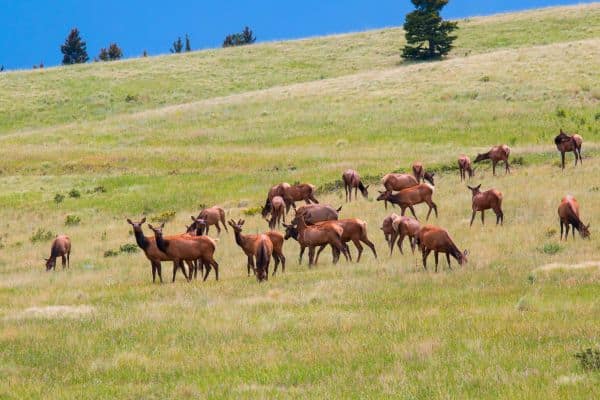
Another hotspot is the Devil’s Thumb Trail, a challenging 13-mile round trip that provides panoramic views of the forest. The trail’s diverse landscapes, from dense woods to open spaces, are often frequented by herds of elk, particularly in the fall during the rutting season.
Elk are known for their impressive antlers, which are shed and regrown annually by the males. These antlers are used in combat with other males during the mating season, leading to intense and powerful displays.
Female elk, or cows, travel in larger groups, often accompanied by their calves during the spring and summer months. If you’re fortunate enough to witness these creatures in their natural habitat, it’s essential to maintain a respectful distance, especially during the rutting season when males can be particularly aggressive.
Observing their natural behaviors, from grazing to social interactions, is a testament to the rich biodiversity of Arapaho National Forest.
Mule Deer
Mule Deer, named for their large, mule-like ears, are a common yet captivating sight in the Arapaho National Forest. Their graceful movements and curious nature make them a favorite among visitors, and their adaptability ensures they’re seen across various terrains within the forest.
One of the most promising trails to encounter these elegant creatures is the Lost Lake Trail, a 4.1-mile round trip that meanders through dense forests and opens up to a picturesque alpine lake. The trail’s diverse vegetation offers ample foraging opportunities for the deer, especially during the early morning and late afternoon.
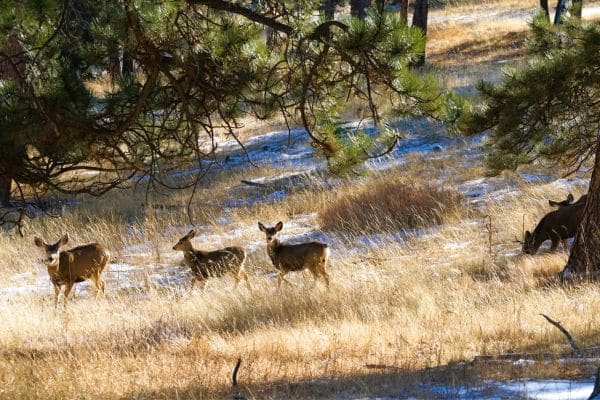
Another excellent location is the King Lake Trail, a 12.2-mile trek that offers a mix of forested paths and meadow clearings. These clearings are often frequented by Mule Deer, especially in the warmer months.
Mule Deer are distinguishable not just by their ears but also by their unique antler structure, which bifurcates in a fork-like manner. Unlike their white-tailed counterparts, Mule Deer have a distinctive bounding gait called “stotting,” where all four feet come off the ground simultaneously.
If you’re exploring the trails of Arapaho, it’s not uncommon to see these deer stotting away when startled. While they’re generally more tolerant of human presence than some other wildlife, it’s always best to observe them from a distance, ensuring they remain undisturbed in their natural habitat.
Moose
Moose, the gentle giants of the Arapaho National Forest, are a sight to behold with their towering stature and broad, palmate antlers. Their sheer size and distinctive features make them one of the most sought-after wildlife encounters in the region.
For those hoping to spot a moose, the Caribou Pass Trail is a top recommendation. This 7.4-mile round trip hike, known for its lush wetlands and dense willow thickets, provides the ideal habitat for moose, who are often seen foraging in the marshy areas.
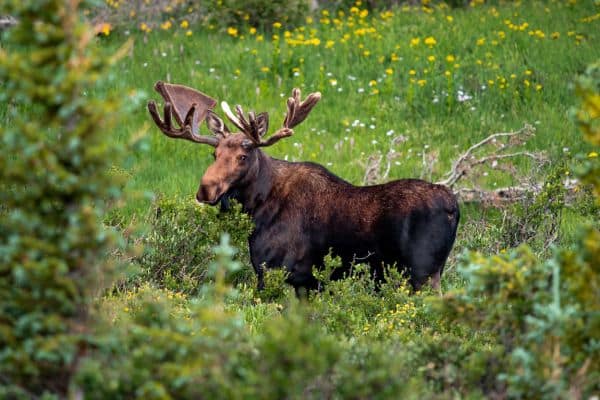
Another prime location is the Junco Lake Trailhead leading to the High Lonesome Trail, an 8-mile stretch that traverses through varied terrains, including ponds and streams favored by moose, especially during the summer months.
Moose are solitary creatures, with males, known as bulls, showcasing impressive antlers that they shed and regrow annually. These antlers play a crucial role during the fall mating season, used in displays and fights for dominance. Female moose, called cows, are often seen with their calves in the spring and early summer, teaching them the ways of the forest.
While moose might appear docile, it’s essential to approach with caution and respect their space. Especially during the rutting season or when a cow is with her calf, moose can be unpredictable.
Observing them from a safe distance, with their majestic silhouette set against the backdrop of Arapaho’s landscapes, is a truly unforgettable experience.
Black Bears
Black Bears, with their shaggy coats and curious demeanor, are one of the most iconic residents of the Arapaho National Forest. These omnivores, while primarily sticking to a plant-based diet, are opportunistic feeders, making their presence felt across various parts of the forest.
For those with a keen interest in spotting these magnificent creatures, the Rollins Pass Trail is a promising start. This 9-mile round trip hike, characterized by its dense forests and berry-rich undergrowth, is a favorite foraging ground for Black Bears, especially during late summer and early fall.
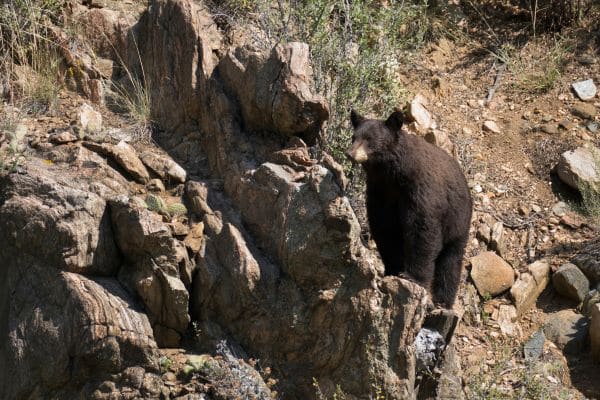
Another trail where bear sightings are frequent is the Knight Ridge Trail, an 11.5-mile stretch that offers a mix of woodlands and open meadows. The trail’s diverse ecosystems provide ample food sources for the bears, from berries to small mammals.
Black Bears are highly adaptable and have an excellent sense of smell, often leading them to campsites in search of food. Hence, it’s crucial for visitors to practice bear-safe habits, like using bear-proof containers and cleaning up after meals.
While they might seem gentle and often avoid human interaction, it’s essential to remember that they are wild animals. If you encounter one, it’s best to speak calmly, avoid direct eye contact, and slowly back away.
Observing a Black Bear in its natural habitat, with the majestic backdrop of the Arapaho National Forest, is a testament to the wild beauty and diversity of the region.
Lark Buntings
Lark Buntings, the state bird of Colorado, are a delightful sight with their striking black and white plumage, especially prominent in males during the breeding season. These songbirds, with their melodious calls, add a musical backdrop to the Arapaho National Forest and are a treat for birdwatchers and hikers alike.
For enthusiasts hoping to observe these avian wonders, the Watrous Gulch Trail is a prime spot. This 3.5-mile round trip hike, known for its open meadows and shrubby areas, provides the perfect habitat for Lark Buntings, who often perch on low shrubs or the ground, singing their hearts out.
Another excellent location is the Bill Moore Lake Trail, a 4.6-mile journey that traverses through varied terrains, from dense forests to open clearings. These clearings are frequented by Lark Buntings, especially during the early morning when they’re most active.
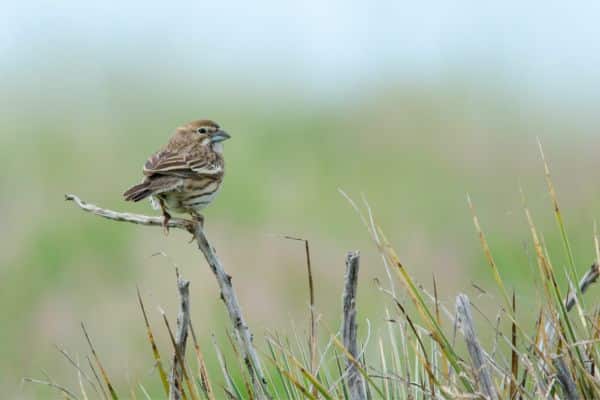
Lark Buntings are unique in their migratory patterns, traveling long distances from their wintering grounds in Mexico to the plains and forests of North America for breeding. Their song, a complex melody with varied notes, is a joy to hear and is often used by males to attract females.
If you’re in the Arapaho National Forest during the spring and summer months, keep an ear out for their song and an eye out for their distinctive flight pattern, characterized by a series of rapid wingbeats followed by short glides.
Observing these birds in their natural setting, against the backdrop of Arapaho’s landscapes, offers a serene and educational experience.
Snowshoe Hares
Snowshoe Hares, with their distinctive large feet and seasonal color-changing fur, are a fascinating inhabitant of the Arapaho National Forest. These hares have a unique adaptation to their environment, with their white winter coat providing camouflage in snowy landscapes and their brown summer coat blending seamlessly into the forest underbrush.
For those eager to spot these elusive creatures, the Diamond Lake Trail is a prime location. This 5.3-mile round trip hike, characterized by its dense forests and undergrowth, offers the ideal habitat for Snowshoe Hares. They’re often seen darting between shrubs or foraging for vegetation.

Another trail where these hares are commonly sighted is the Fourth of July Trail, a 4.1-mile trek that winds through thickets and meadows, areas frequented by the hares, especially during dawn and dusk.
Snowshoe Hares have a unique life cycle, with their population numbers rising and falling in a near-decade-long cycle. Their large hind feet, which give them their name, act like natural snowshoes, allowing them to move effortlessly across snow-covered terrains.
An interesting aspect of these hares is their ability to have multiple litters in a year, ensuring their survival in the challenging wilderness.
If you’re exploring the trails of Arapaho, tread softly and keep a keen eye on the underbrush. Spotting a Snowshoe Hare, with its twitching nose and alert eyes, offers a glimpse into the delicate balance of nature in the forest.
Ferruginous Hawks
Ferruginous Hawks, the largest hawks of North America, are a majestic sight soaring above the Arapaho National Forest. Recognized by their broad wings, rust-colored feathers, and powerful build, these raptors command the skies, scanning the ground for prey with their keen eyes.
For birdwatchers and enthusiasts, the Niwot Ridge Trail is a favored spot. This 6-mile round trip hike, known for its open landscapes and panoramic views, provides an ideal vantage point to observe these hawks in flight.
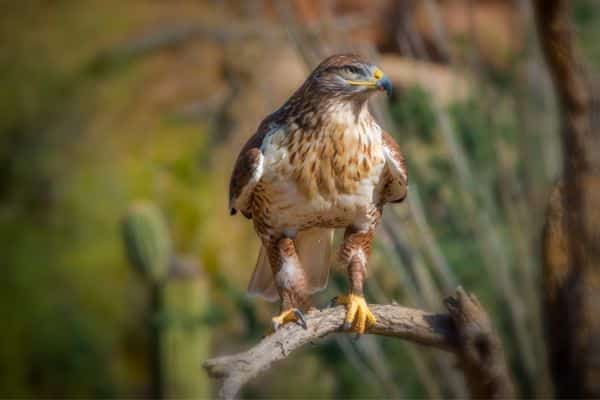
Another excellent location is the Roaring Fork Trail, a 7.2-mile journey that offers a mix of open grasslands and forested areas. The expansive meadows here are often hunting grounds for the Ferruginous Hawks, especially during the morning hours.
Ferruginous Hawks primarily feed on small mammals, with prairie dogs and rabbits being their preferred prey. Their nests, often built on cliff edges or tall trees, are massive structures made of sticks and can be used year after year. An intriguing aspect of these hawks is their ability to adapt to ground nesting in areas devoid of tall perches.
Their name “ferruginous” comes from the Latin word for iron, referring to their rust-colored plumage. If you’re traversing the vast landscapes of Arapaho, looking up might reward you with the sight of a Ferruginous Hawk, wings spread wide, riding the thermals and showcasing the wild essence of the region.
Squirrels
Squirrels, with their twitching tails and agile movements, are among the most delightful and ubiquitous residents of the Arapaho National Forest. These small mammals, with their keen sense of curiosity, can often be seen darting up trees, foraging for nuts, or playfully chasing one another across the forest floor.
For those looking to observe these energetic creatures, the Rainbow Lakes Trail is a top choice. This 2.5-mile round trip hike, characterized by its dense woodlands and interspersed clearings, is a haven for various squirrel species.
The Hessie Trailhead leading to Lost Lake, a 4-mile round trip, is another hotspot, with its mix of coniferous trees and ground vegetation providing ample food and shelter for squirrels.
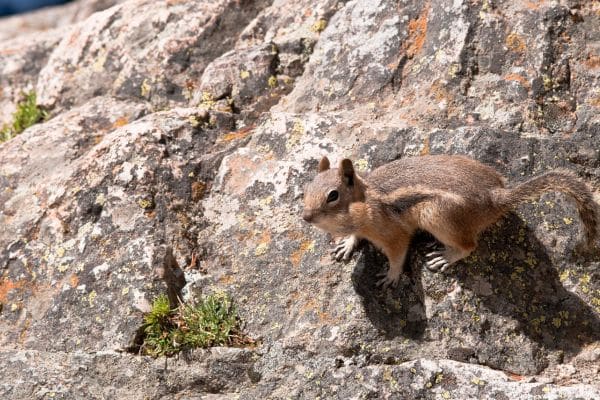
In the Arapaho National Forest, you’ll primarily encounter the Abert’s squirrel, recognizable by its tufted ears, and the Golden-mantled ground squirrel, with its striking black and white stripes.
While squirrels are often associated with acorns, their diet is diverse, including seeds, berries, fungi, and even small insects. An interesting behavior to watch for is their food caching habit, where they bury food in the ground to retrieve during leaner times.
If you’re picnicking or camping in Arapaho, it’s not uncommon to have a curious squirrel or two approach, hoping for a treat. While their antics are entertaining, it’s essential to avoid feeding them, ensuring they maintain their natural foraging behaviors and diet.
Burrowing Owls
Burrowing Owls, with their bright yellow eyes and long legs, offer a unique and enchanting bird-watching experience in the Arapaho National Forest.
Unlike most owls, these petite raptors are diurnal, making them easier to spot during daylight hours. Their name derives from their unusual nesting behavior, as they often take residence in burrows, typically abandoned by prairie dogs.
For those keen on observing these ground-dwelling owls, the open grasslands near the South Boulder Creek Trail are a prime location. This 3.7-mile trail, known for its expansive meadows and gentle slopes, is a habitat where Burrowing Owls often establish their nests.
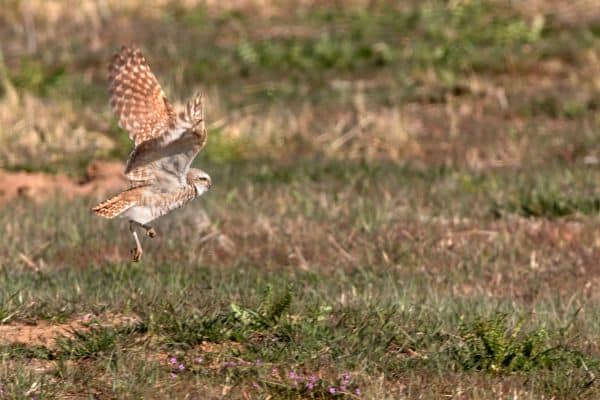
Another promising spot is the Columbine Gulch Trail, a 5-mile round trip that traverses through open terrains and offers ample opportunities to spot these owls perched near their burrows or on low fences.
Burrowing Owls have a varied diet, feeding on insects, small mammals, and even birds. Their distinct call, a series of cooing notes, can often be heard during early morning or late evening, especially during mating season.
One of the most endearing behaviors of these owls is their “bobbing” motion when they feel threatened or curious, making them a favorite among bird enthusiasts.
If you’re exploring the open landscapes of Arapaho, keep an eye near the ground. Spotting a Burrowing Owl, standing sentinel at its burrow or scanning the horizon with its intense gaze, is a memorable and heartwarming experience.
Bald Eagles
Bald Eagles, with their striking white heads, yellow beaks, and impressive wingspans, are a symbol of majesty and freedom in the Arapaho National Forest. These raptors, once endangered but now thriving, are a testament to conservation efforts and the resilience of nature.
For those hoping to witness the grandeur of these birds, the Heart Lake Trail is an excellent starting point. This 8-mile round trip hike, known for its pristine lakes and towering pines, often sees Bald Eagles soaring overhead or perched high scouting for fish.
Another prime location is the St. Vrain Mountain Trail, a 7.4-mile trek that offers panoramic views of the forest and open skies, ideal for spotting these eagles in flight.
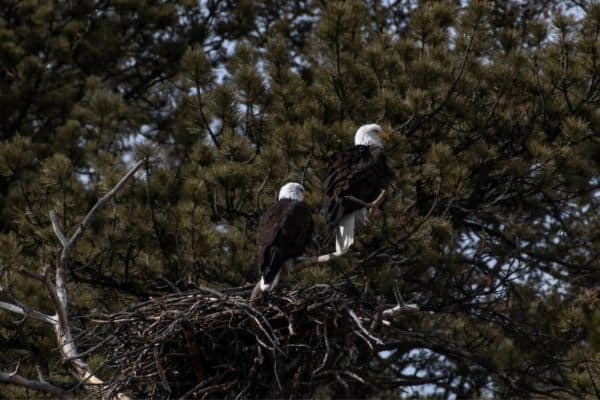
Bald Eagles primarily feed on fish, and their incredible eyesight allows them to spot potential prey from great heights. They have a unique hunting technique, swooping down with incredible speed and precision to snatch fish from the water’s surface.
Their nests, known as aeries, are massive structures built on tall trees or cliffs and can weigh up to a ton. An interesting fact about Bald Eagles is their monogamous nature; they often mate for life and work together to raise their young.
If you’re in the Arapaho National Forest, especially near water bodies, take a moment to look up. The sight of a Bald Eagle, wings outstretched against the backdrop of the vast sky, is a powerful and awe-inspiring experience.
Mountain Plovers
Mountain Plovers, with their subtle brown plumage and delicate features, are a lesser-known yet integral part of the Arapaho National Forest‘s avian community. These ground-nesting birds prefer open landscapes, making the expansive meadows and grasslands of Arapaho their ideal habitat.
For birdwatchers eager to spot these elusive birds, the Meadow Creek Trail is a recommended location. This 4.8-mile round trip hike, characterized by its open grasslands and gentle slopes, is frequented by Mountain Plovers, especially during their breeding season.

Another promising spot is the Lone Eagle Peak Trail, a 15.5-mile journey that, while longer, traverses through vast open terrains where these birds are often sighted.
Mountain Plovers are unique in their nesting habits. Instead of building nests in trees or shrubs, they lay their eggs in shallow depressions on the ground, often amidst short grass or even on bare soil.
Their cryptic coloration helps them blend seamlessly into their surroundings, providing a natural camouflage against predators. Their diet primarily consists of insects, and they can often be seen running short distances to catch beetles or grasshoppers.
An interesting aspect of Mountain Plovers is their migratory behavior; while they breed in the high-altitude regions of Colorado, they winter in the plains of California and northern Mexico.
If you tread softly and keep a keen eye on the ground while exploring Arapaho’s open landscapes, you might be rewarded with a glimpse of this fascinating and graceful bird.
Antelope
Antelope, specifically the Pronghorn Antelope, are a symbol of the American West’s open landscapes, and their presence in the Arapaho National Forest adds to the region’s rich biodiversity. With their sleek bodies, white markings, and distinctive horned crowns, Pronghorns are a sight that embodies the spirit of the wild.
For those looking to observe these swift creatures, the Vasquez Peak Wilderness area within the forest is a prime location. This expansive region, with its mix of grasslands and rolling hills, offers the open spaces Pronghorns prefer.
The Byers Peak Trail, a 9-mile round trip that provides sweeping views of the forest, is another hotspot where these animals are often seen grazing or sprinting across the landscape.

Pronghorns hold the title of the second-fastest land animal in the world, capable of reaching speeds up to 55 mph. This incredible speed, combined with their remarkable endurance, allows them to escape predators and cover vast distances.
Their large eyes, set high on their heads, give them a nearly 360-degree field of vision, an adaptation that’s crucial in the open terrains they inhabit. An intriguing fact about Pronghorns is that, despite being colloquially called “antelope,” they are not true antelopes and have a unique lineage in North America.
If you’re journeying through the open areas of Arapaho National Forest, the sight of a Pronghorn herd against the backdrop of the Rockies is a timeless and unforgettable spectacle.
Red-tailed Hawks
Red-tailed Hawks, with their broad wings, sharp talons, and namesake russet tail, are a commanding presence in the skies of the Arapaho National Forest. These raptors, known for their piercing cries and impressive aerial displays, are a testament to the wild spirit of the region.
For those with a keen eye and a passion for birdwatching, the Jones Pass Trail is a favored location. This 6.5-mile round trip hike, with its open vistas and towering pines, often sees Red-tailed Hawks riding the thermals, scanning the ground for prey.
Another excellent vantage point is the Silver Dollar Lake Trail, a 3.9-mile journey that offers a mix of forested canopies and open skies, ideal for observing these hawks in their natural hunting grounds.
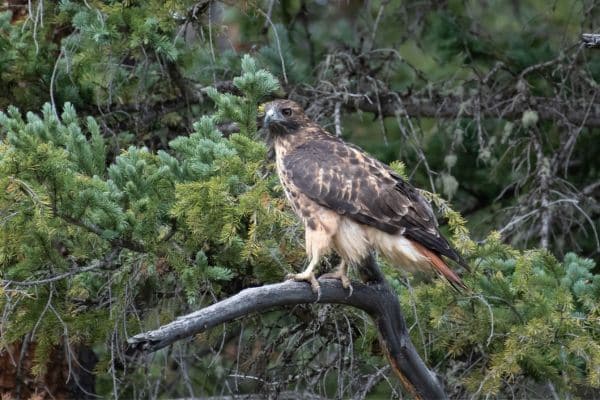
Red-tailed Hawks are versatile predators, with a diet ranging from small mammals like voles and squirrels to birds and reptiles. Their keen eyesight, combined with their soaring height, allows them to spot potential prey from afar, diving in a swift and precise manner to make a catch.
The distinctive reddish-brown tail, especially prominent in adults, is a key identifier for this species. An interesting behavior to note is their monogamous nature; these hawks often mate for life, building nests together on high perches.
As you traverse the trails of Arapaho National Forest, the echoing cry of a Red-tailed Hawk overhead is a reminder of the wild, untamed beauty of the region.
Pika
Pikas, with their round bodies, large ears, and high-pitched calls, are one of the most endearing residents of the Arapaho National Forest. These small, rabbit-like mammals are perfectly adapted to life in high-altitude alpine environments, often seen amidst rocky talus slopes and boulder fields.
For those hoping to catch a glimpse of these elusive creatures, the Mount Audubon Trail is a top recommendation. This 8-mile round trip hike, known for its rocky terrains and alpine meadows, is a habitat where Pikas often gather vegetation and dart between boulders.
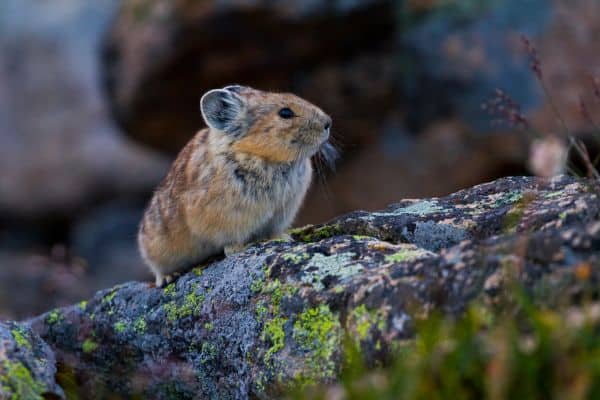
Another favored spot is the Pawnee Pass Trail, a 9.4-mile trek that traverses through high-altitude terrains, offering ample opportunities to hear the distinctive “eep” call of the Pika.
Pikas are known for their industrious nature. During the warmer months, they busily collect grasses and other vegetation, creating “haystacks” to store and feed on during the harsh winter months. Their thick fur and rapid metabolism help them survive the cold alpine temperatures.
An interesting aspect of Pikas is their sensitivity to climate change. Due to their reliance on cooler temperatures, they serve as an indicator species, with their behavior and distribution providing insights into changing environmental conditions.
If you’re exploring the higher elevations of Arapaho National Forest, a moment spent watching a Pika, with its cheeks bulging with food or emitting its signature call, is a heartwarming and memorable experience.
Prairie Dogs
Prairie Dogs, with their alert eyes, chattering calls, and communal burrows, are a lively and integral part of the Arapaho National Forest ecosystem. These social rodents, often seen standing on their hind legs keeping watch, add a dynamic element to the grasslands and open areas of the forest.
For those interested in observing these animated creatures, the Buffalo Meadows Trail is an ideal location. This 5.2-mile round trip hike, characterized by its expansive grasslands and gentle slopes, is home to several prairie dog colonies, making it a hub of activity, especially during the warmer months.
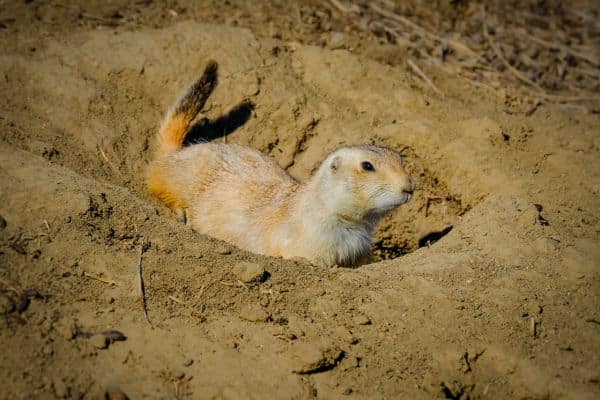
Another hotspot is the South Fork Loop, a 3.7-mile trail that meanders through open terrains where prairie dogs frequently establish their burrows.
Prairie Dogs live in complex, interconnected burrows known as “towns,” which can house hundreds to thousands of individuals. These towns play a crucial role in the ecosystem, providing shelter for other animals and aerating the soil, which promotes plant growth.
Their diet primarily consists of grasses, seeds, and insects. An intriguing behavior of prairie dogs is their “jump-yip” display, a combination of a sudden leap into the air followed by a sharp, yipping call, often triggering a wave of similar responses from others in the colony.
As you journey through the open landscapes of Arapaho National Forest, the sight and sounds of prairie dog towns bustling with activity offer a fascinating glimpse into the intricate web of life in the region.
Bobcat
Bobcats, with their tufted ears, spotted coat, and stealthy demeanor, are one of the more elusive yet captivating predators of the Arapaho National Forest. These medium-sized wildcats, named for their short, “bobbed” tail, are masters of camouflage and ambush, often moving silently through the underbrush in search of prey.
For those with a keen interest in spotting these wild felines, the Blue Lake Trail is a promising location. This 5.1-mile round trip hike, with its dense forests, rocky outcrops, and secluded clearings, provides the kind of cover and habitat bobcats prefer.
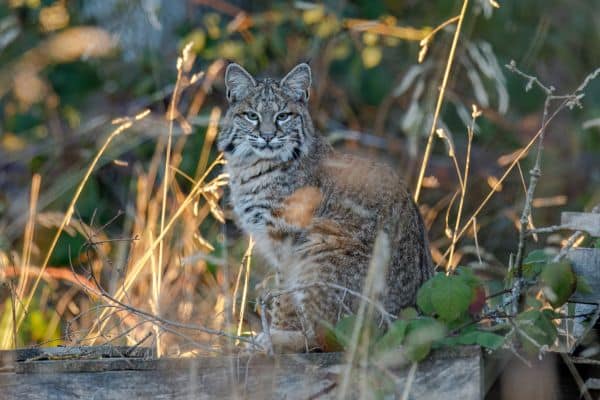
Another potential spot is the Devil’s Canyon Trail, a 6.5-mile journey that winds through thickets and along streambeds, areas where bobcats might be seen stalking or resting during the cooler hours of the day.
Bobcats are solitary and territorial creatures, marking their domains with scent markings to ward off potential rivals. Their diet is varied, ranging from small mammals like rabbits and rodents to birds and even larger prey like deer.
Their sharp retractable claws and keen senses make them formidable hunters. An interesting aspect of bobcats is their adaptability; they can thrive in various habitats, from forests and mountains to urban fringes.
While sightings of bobcats in the Arapaho National Forest can be rare due to their elusive nature, the mere possibility of crossing paths with one adds an element of mystery and wonder to any hike in the region.
Red Foxes
Red Foxes, with their fiery coats, bushy tails, and keen eyes, are a delightful and cunning presence in the Arapaho National Forest. These adaptable canids, recognized by their pointed ears and white-tipped tails, are often seen during the twilight hours, gracefully moving through meadows or along forest edges.
For those hoping to observe these elegant creatures, the Echo Lake Trail is a prime spot. This 3.5-mile round trip hike, known for its mix of open spaces and dense woodlands, offers the diverse environment that red foxes favor.
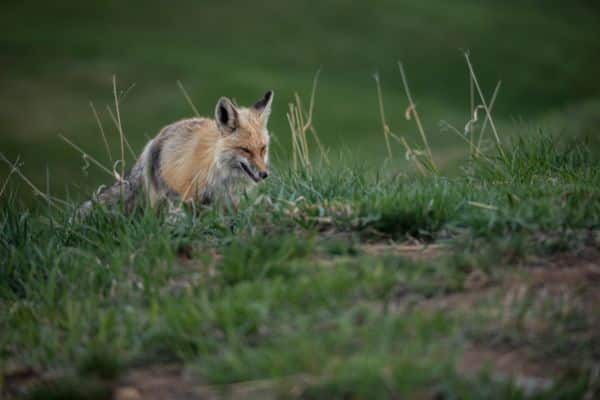
Another promising location is the Chinns Lake Trail, a 4-mile trek that traverses through varied terrains, from thickets to open clearings. These areas are frequented by red foxes, especially during dawn and dusk when they’re most active.
Red Foxes are omnivores with a varied diet that includes small mammals, birds, fruits, and insects. Their keen sense of hearing allows them to detect the faintest sounds, aiding them in locating prey hidden beneath the snow or ground cover.
An interesting behavior of red foxes is their “mousing jump,” a high, arching leap they use to pounce on prey from above. Their adaptability is also noteworthy; they can thrive in various habitats, from wild forests to urban areas.
As you explore the trails and landscapes of Arapaho National Forest, the sight of a red fox, with its vibrant coat contrasting against the natural greens and browns, is a moment of pure, wild beauty.
Wilderness Areas in Arapaho National Forest
The Arapaho National Forest, a testament to Colorado’s unparalleled natural beauty, is punctuated by six pristine wilderness areas.
Each of these sanctuaries offers a unique blend of ecological wonders, hiking adventures, and wildlife encounters.
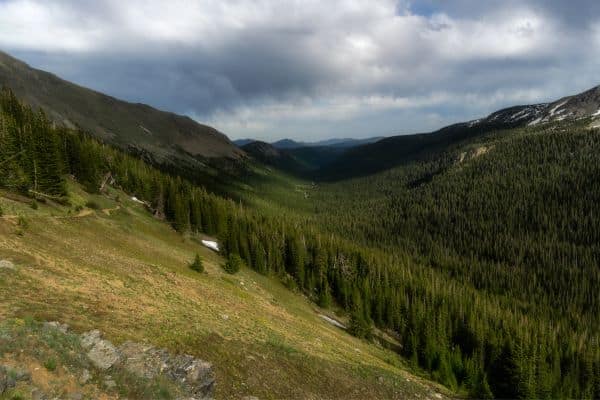
Drawing from our extensive exploration of this region, we present an authoritative guide to these untouched realms.
1. Byers Peak Wilderness (13.93 square miles)
Deep within the Arapaho National Forest, the Byers Peak Wilderness is a compact yet ecologically diverse treasure. Dominated by the imposing Byers Peak, this wilderness area boasts a series of trails that cater to both novice hikers and seasoned adventurers.
While the region is accessible throughout the year, the period from late spring to early fall is particularly enchanting, with wildflowers painting the landscape in a riot of colors.
The dense forests here are home to mule deer, while the meadows often echo with the playful antics of red foxes. For those seeking a blend of tranquility and moderate adventure, Byers Peak Wilderness is a must-visit.
2. Indian Peaks Wilderness (119.9 square miles)
Spanning the territories of the Arapaho and Roosevelt National Forests, the Indian Peaks Wilderness stands as a vast expanse of alpine majesty. With over a hundred miles of meticulously maintained trails, it’s a haven for hikers.
Key trailheads like Blue Lake and Long Lake are particularly popular, offering routes that wind through dense forests, past serene lakes, and up challenging ascents.
Wildlife enthusiasts are in for a treat, with frequent sightings of majestic elk, elusive mountain lions, and curious black bears. The region’s accessibility, combined with its diverse ecosystems, makes it a favorite among nature lovers.
3. James Peak Wilderness (26.59 square miles)
Primarily located within the Roosevelt National Forest, the James Peak Wilderness is a harmonious blend of alpine lakes, sprawling meadows, and glaciated valleys. T
he Heart Lake Trail stands out as a favorite, offering a moderate hike that culminates in breathtaking views of the surrounding landscape.
During the summer months, the region transforms into a vibrant tapestry of wildflowers, with colors spanning the spectrum.
The wilderness also serves as a habitat for a diverse range of wildlife, from chirping songbirds to agile mountain goats, making every hike an opportunity for unexpected encounters.
4. Mount Evans Wilderness (116.3 square miles)
Shared with the Pike National Forest, the Mount Evans Wilderness is an epitome of high-altitude grandeur. Dominated by Mount Evans, one of Colorado’s iconic 14ers, this area is a magnet for mountaineers and casual hikers alike.
The Mount Evans Scenic Byway, renowned as the highest paved road in North America, offers unparalleled panoramic views and serves as a gateway to numerous trailheads.
Ancient bristlecone pines, some of the oldest living trees on Earth, dot the landscape, standing as silent witnesses to the passage of time. The region’s alpine meadows and rocky outcrops are also frequented by mountain goats, their white coats standing in stark contrast to the rugged terrain.
5. Never Summer Wilderness (32.95 square miles)
Straddling the Arapaho and Routt National Forests, the Never Summer Wilderness is a realm of contrasts. Named for its perpetually cool climate, this wilderness area is a mosaic of lush valleys, dense spruce-fir forests, and shimmering streams.
Trails like the Bowen Gulch Trail offer immersive experiences, winding through dense woodlands and opening up to expansive meadows.
The region is particularly known for its moose population, with these gentle giants often seen grazing near water sources or resting in the shade of towering pines.
6. Vasquez Peak Wilderness (19.22 square miles)
The Vasquez Peak Wilderness, with its undulating terrains and pristine landscapes, is a haven of tranquility. Popular trails like the Jones Pass and Vasquez Peak Trail cater to hikers of all skill levels, meandering through dense forests and across alpine meadows.
The region’s streams, teeming with freshwater fish, are a delight for anglers, while its meadows and forests are home to a diverse range of wildlife, from the elusive lynx to the chirpy pika.
The wilderness areas of the Arapaho National Forest are more than just landscapes; they are living, breathing realms of wonder. Each area, with its unique character and offerings, beckons travelers to embark on a journey of discovery, where every step unveils the myriad secrets of nature.
Wildlife Hikes in Arapaho National Forest
The Arapaho National Forest, a sprawling expanse of wilderness in the heart of Colorado, is a haven for wildlife enthusiasts and hikers alike. Its diverse ecosystems, ranging from dense woodlands to alpine meadows, are home to a myriad of creatures, each adding a unique touch to the forest’s vibrant tapestry of life.
For those eager to combine the thrill of hiking with the joy of wildlife sightings, Arapaho offers a plethora of trails that promise both adventure and serendipitous encounters.
Popular Trails for Wildlife Sightings:
- Echo Lake Trail: This 3.5-mile round trip is a favorite among birdwatchers. The trail, which winds around a serene lake and through dense forests, offers sightings of species like the Red-tailed Hawk, Lark Bunting, and even the elusive Bald Eagle.
- Niwot Ridge Trail: Spanning 6 miles round trip, this trail is known for its open landscapes. It’s an ideal spot to observe larger mammals like elk, mule deer, and occasionally, the stealthy mountain lion.
- Rainbow Lakes Trail: A relatively short 2.5-mile round trip, this trail is a hotspot for smaller mammals. The dense woodlands here are often bustling with squirrels, pikas, and snowshoe hares.
- Jones Pass Trail: This 6.5-mile trail, with its open vistas and alpine meadows, is frequented by herds of bighorn sheep and mountain goats, especially during the early morning hours.
Our Recommendations:
On our numerous hikes through the Arapaho National Forest, we’ve had the privilege of witnessing the forest’s wildlife in all its glory. One particularly memorable experience was on the Niwot Ridge Trail.
As we ascended a gentle slope, a majestic elk, crowned with a magnificent set of antlers, emerged from the morning mist. The creature, seemingly undisturbed by our presence, grazed peacefully, allowing us to capture some unforgettable photographs.
The Rainbow Lakes Trail, with its dense canopy and serene ambiance, offered us a delightful encounter with a family of pikas. Their playful antics and high-pitched calls added a touch of magic to our hike.
For those specifically interested in birdwatching, the Echo Lake Trail has never disappointed. On our last visit, the sight of a Bald Eagle, soaring gracefully against the backdrop of a cerulean sky, was a sight to behold.
Tips for Maximizing Wildlife Encounters on Hikes:
- Dawn and Dusk: Wildlife is most active during the cooler hours of dawn and dusk. Planning your hike around these times increases the chances of sightings.
- Silence is Golden: Move quietly. Loud noises can scare away animals. If you’re hiking in a group, communicate in hushed tones.
- Stay on the Trail: While the urge to venture off the beaten path can be strong, it’s essential to stay on designated trails to minimize disturbance to wildlife habitats.
- Binoculars and Cameras: Always carry a pair of binoculars and a camera. Binoculars enhance your viewing experience, and a camera helps capture those unexpected moments.
- Safety First: While encounters with wildlife can be exhilarating, it’s crucial to maintain a safe distance. Never approach or feed wild animals. If you come across predators like mountain lions or bears, avoid direct eye contact, make yourself appear larger, and back away slowly.
- Educate Yourself: Before embarking on a hike, familiarize yourself with the wildlife native to the area. This not only enhances your experience but also ensures that you can identify and appreciate the creatures you come across.
- Leave No Trace: Preserve the beauty and sanctity of the forest by adhering to the ‘Leave No Trace’ principles. Carry out whatever you carry in, and avoid leaving food scraps that might attract wildlife.
The Arapaho National Forest, with its rich biodiversity and network of trails, is a paradise for wildlife enthusiasts. Each hike offers a unique opportunity to connect with nature, to witness the raw, untamed beauty of the wild, and to carry back memories that last a lifetime.
As you lace up your hiking boots and set out on these trails, remember that you’re not just a visitor; you’re a custodian of the forest’s timeless legacy.
15 Tips to See Animals While Hiking in Arapaho National Forest
- Seasonal Timing: Visit during late spring or early summer. Many animals in Arapaho, like elk and mule deer, are more active during their calving season, which typically falls in these months.
- Dawn and Dusk at Echo Lake: The Echo Lake Trail is known for birdwatching. Plan your hike during the early morning or late evening when birds like the Red-tailed Hawk or Bald Eagle are most active.
- Niwot Ridge for Larger Mammals: For a chance to spot elk or even the elusive mountain lion, hike the Niwot Ridge Trail, especially around dawn or dusk.
- Listen for Pikas: As you traverse areas with rocky terrains, like parts of the Rainbow Lakes Trail, listen for the distinctive calls of pikas, especially during warmer months.
- High Altitude Hikes for Bighorns: Trails that ascend to higher altitudes, such as Jones Pass Trail, often have herds of bighorn sheep grazing in alpine meadows.
- Stay Overnight: Consider multi-day hikes or camping in designated areas. Animals are often more active during the night, and the serene early mornings can offer excellent viewing opportunities.
- Look for Animal Tracks: Familiarize yourself with the tracks of animals native to Arapaho. Fresh tracks can guide you to recent animal activity.
- Visit Water Sources: Animals frequent water sources, especially during dryer months. Trails that pass by streams or lakes, like parts of the Vasquez Peak Wilderness, can be hotspots for wildlife.
- Be Patient at Clearings: Open areas or clearings, especially in dense forest regions, are often grazing spots for deer and elk. Find a quiet spot, sit down, and wait patiently.
- Avoid Peak Human Traffic: Animals tend to shy away during peak hiking hours. Opt for weekdays or off-peak hours to hike popular trails.
- Use Local Knowledge: Before setting out, chat with local rangers or visit the Arapaho National Forest’s visitor center. They often have up-to-date information on recent wildlife sightings.
- Minimize Noise: While it’s essential to make noise in bear country to avoid startling them, in general areas, move quietly to observe more wildlife.
- Look Up: While hiking in forested areas, don’t just focus on the ground. The dense canopies of Arapaho are home to various bird species. Carry a bird guide specific to Colorado to identify them.
- Bear Safety: Black bears are residents of Arapaho. While it’s thrilling to spot one, ensure you’re aware of bear safety guidelines. Carry bear spray, especially if venturing into dense, less-traveled areas.
- Respect Wildlife: Always view animals from a distance. Approaching or feeding them not only endangers you but can also harm the animals and alter their natural behaviors.
Remember, while the goal is to witness the majestic wildlife of Arapaho National Forest, it’s equally crucial to ensure their safety and well-being. Always prioritize responsible wildlife viewing practices.
Best Time to Visit Arapaho National Forest for Animal Sightings
Arapaho National Forest, a mosaic of pristine landscapes and diverse habitats, is a wildlife enthusiast’s dream. The forest’s inhabitants, from majestic elk to chirping birds, follow the rhythms of the seasons, making certain times of the year particularly rewarding for sightings.
While each season has its charm, based on our extensive experiences and observations, we highly recommend visiting during the fall. Here’s why:
Overview of Seasonal Animal Activities:
Spring (April to June): Spring heralds the forest’s awakening. As the snow retreats, elk and mule deer begin their calving season. Birds return from their winter migrations, filling the air with melodic songs. While spring is vibrant, the unpredictable weather can sometimes be a deterrent.
Summer (July to September): Summer in Arapaho is a bustling time. Pikas, snowshoe hares, and squirrels are especially active. Birds, from Lark Buntings to Red-tailed Hawks, are in abundance. However, the trails can get crowded, and the animals, wary of human presence, might be less visible during peak hours.
Fall (October to November): Fall is a magical time in Arapaho. The forest is a canvas of golds and reds, and the cooler temperatures make hiking a pleasure. This is the period of the elk rut, where male elks engage in powerful displays of dominance. The crisp air and reduced foot traffic mean animals are more active during the day, increasing the chances of sightings.
Winter (December to March): Winter transforms Arapaho into a serene wonderland. While many animals hibernate or migrate, you can still spot snowshoe hares and resilient bighorn sheep. Birds of prey, like Bald Eagles, stand out against the snowy backdrop.
Recommendations Based on Personal Experiences:
Why Fall Stands Out: Our treks during fall, especially on the Rainbow Lakes Trail, have been nothing short of spectacular. The forest, with its vibrant foliage, creates a backdrop that accentuates the beauty of its inhabitants.
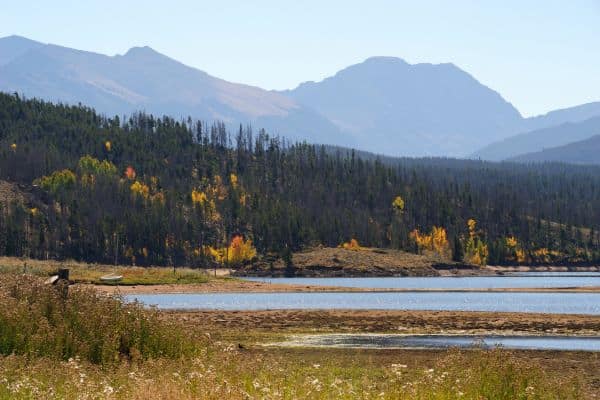
The reduced human activity means animals like bobcats, black bears, and mule deer are more visible and less skittish. The sounds of the forest, particularly the haunting bugle of the male elk, add an auditory depth to the experience.
Insights on Migration Patterns and Breeding Seasons:
Bird enthusiasts should note that many avian species in Arapaho are migratory. While spring sees their return, fall is when they prepare for their onward journey, making it a bustling time for bird activity.
Elk, the forest’s crown jewels, are particularly active during fall. The rutting season, with its displays of strength and dominance, is a must-witness event. The cooler temperatures also mean that animals are active for longer periods during the day, increasing the chances of sightings.
While Arapaho National Forest promises a rich wildlife experience throughout the year, fall stands out as the prime time for animal sightings.
The combination of favorable weather, reduced crowds, and heightened animal activity makes it our top recommendation. Whether you’re an avid wildlife photographer or someone seeking a serene communion with nature, a fall visit to Arapaho will undoubtedly be a memorable one.
Conclusion
Arapaho National Forest, with its vast landscapes, diverse ecosystems, and rich tapestry of wildlife, stands as a testament to nature’s grandeur. Each trail, wilderness area, and season offers a unique window into the forest’s soul, revealing stories of survival, beauty, and coexistence.
While every visit promises a blend of adventure and serenity, it’s the informed choices, based on understanding the forest’s rhythms and respecting its inhabitants, that make the experience truly enriching.
Whether you’re tracing the footsteps of elusive mountain lions, witnessing the powerful elk rut, or simply soaking in the forest’s tranquility, Arapaho beckons with experiences that linger long after the journey ends.
As stewards of nature, it’s our privilege to explore, appreciate, and protect this magnificent realm, ensuring that its stories continue to inspire generations to come.

